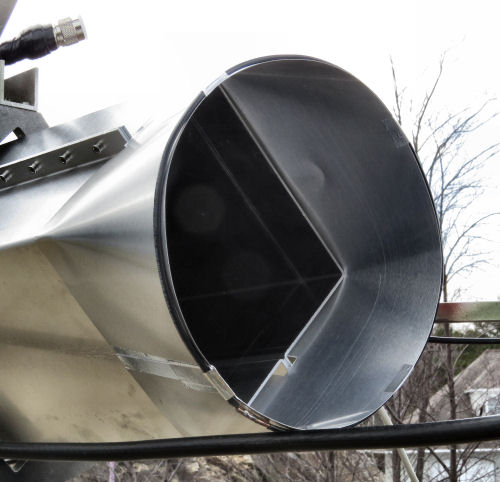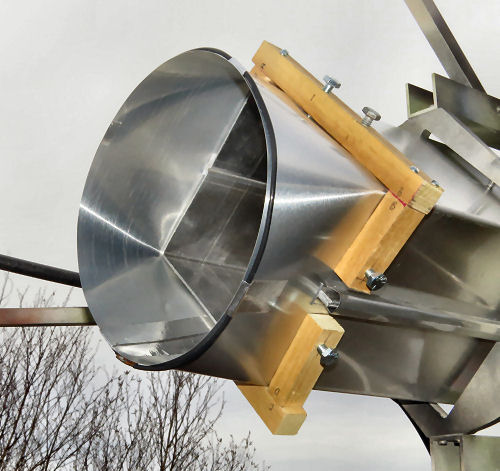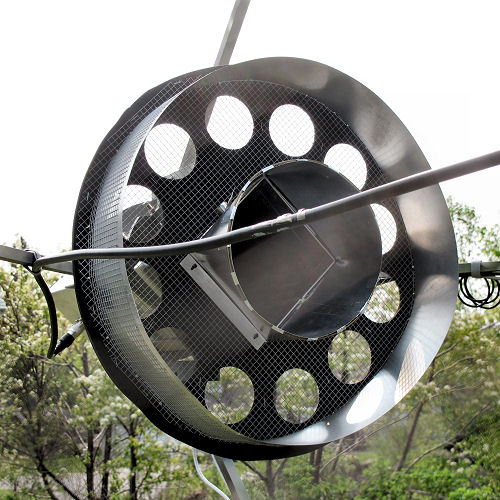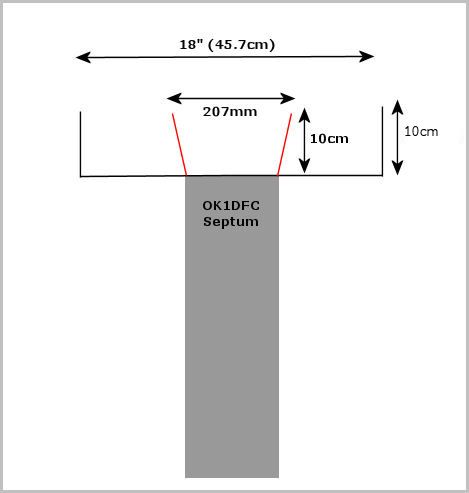"GT" Flare for OK1DFC 23cm Septum Feed
Note #1: This article describes changes I made to the feed as I went from the original 2.4m dish with and f/d of 0.45 to the eventual expanded 3.15m dish with an f/d of 0.34. It's a record of what I did and what seemed to work. I've done no modeling, all results reported are actual measurements.
Note #2: There is an UPDATE of this article which describes a new septum feed with flare and choke
The OK1DFC septum feed is probably the most popular feed in use today for 1296MHz EME. It's optimized for maximum efficiency with dishes around 0.37 F/D ratio, so works well for F/D rations from 0.35 to 0.4. For dishes with an F/D ratio of 0.45, the beamwidth is a little wide, resulting in slightly lower efficiency and more spillover which leads to a higher antenna noise temperature and lower G/T (gain to temperature ratio). Addition of a choke ring can improve feed efficiency and push the optimum F/D ratio slightly higher, though on a small dish the additional feed blockage can reduce improvement, plus adding a circular choke ring to the square feed requires a fair amount of mechanical construction. However another way to possibly improve efficiency (and G/T) by tighten up the beamwidth is to put a flared extension on the feed.
The septum feed waveguide is approximately 149mm on each size (outside measurement, 146mm inside), which give is a perimeter of 596mm. If this square is re-shaped into a circle, the 596mm (149mmx4)circumference means the circle will have a diameter of 189.7mm. The beamwidth of a wave exiting open waveguide depends on the size of the waveguide, with smaller sizes producing a wider pattern. For the square waveguide with circular polarization the beamwidth will be determined by the internal width (around 146mm in this case) and will be larger than for the same waveguide bent into a 190mm diameter circular shape.
What this means is that if we extend the septum waveguide using thin aluminum sheet, then distort the open end of this extension form square to circular, this should result in a slightly narrower beamwidth.
The septum feed is 0.635 wavelengths across (~146MM). The square to circular flare described results in a 0.825 wavelength aperture. Paul Wade W1GHZ has looked at models for flares (http://www.w1ghz.org/antbook/conf/SEPTUM.pdf) and found that a square flare with a 1.1 wavelength aperture is optimum for a dish with and F/D ration of around 0.55 and a 1.4 wavelength aperture square flare gives a beam pattern which suits dishes with an F/D ratio around 0.75. Paul also found that cutting the corners off the square (making the flare aperture octagonal) improves the pattern and increases efficiency by reducing back lobes and lowered cross polarization losses. If an octagon is better than a square,then it seems reasonable to assume that a circle would probably be at least as good as, and possibly better than, an octagon - plus it's easier to make in this particular design. If you look at the aperture dimensions vs optimum F/D, it looks like somewhere around 0.85 wavelengths should be about correct of a 0.45 F/D dish, which isn't fare from the 0.825 wavelength aperture you get when you distort the square OD of the feed into a circle. So based on my interpolation of Paul's modeling results the square to circular distortion should provide a decent maximum efficiency match to a 0.45 F/D dish.
The convenient aspect of the particular waveguide flare described here is that the shape is simple. The aluminum sheet used to make it is a rectangle. The dimensions are 596mm along the side that wraps around the septum feed and flares into a circular aperture and the other side determines the length of the flare (which in turn determines the angle of the flare). So a thin aluminum sheet approximately 600mm x 90mm is what I used.

"GT" square to circular flare for a 0.45 F/D dish using the OK1DFC design septum feed
The construction is pretty simple. You take the 600x90mm sheet and form a 190mm diameter cylinder, joining the two ends with adhesive aluminum tape. You then deform one end to fit over the square septum feed (with cut-outs if necessary for the seams).

Take the sheet, bend it into a cylinder, overlap the ends by 4mm so the ID is 190mm
I used Aluminum flashing strip from Home Depot, which is pretty springy, so I made a circular wire loop of the right size to fit the open end of the flare and hold it in a circular shape - and again attached it to the flare using adhesive aluminum tape. This can be seen in the figure above. The corners of the square end are a tight fit over the feed and so make good electrical contact. The edges of the square section bow away from the feed slightly and this does affect performance. The edges should be secured to the feed using screws, a clamp or conductive metal tape. The picture below shoes a crude wooden clamp, it works but I'm sure there are better ways to do this!

The wooden clamp keeps the edges of the flare in contact with the feed
Does it actually improve performance? It's easy to fool yourself into thinking something you have built that you think should work actually does work! However on the whole I think the answer is yes. Over a number of tests I do see a slight improvement in sun noise. Based on noise level of the quiet sky I do see a reduction in noise suggesting less spillover. On one set of tests, my best sun noise was around 7.3dB with the septum feed alone and around 7.8dB with the flare added. At elevation angles between 30 degrees and 90 degrees I saw about 1.25 dB lower sky noise, presumably due to less spillover. I have not run any tests to estimate the effect of the flare on the antenna gain yet, but G/T temperature is certainly better (more sun noise). It's possible that absolute gain could be slightly lower.
Dish expanded to 2.7m
After adding a small "skirt" to the dish, and making it an effective 2.7m 0.4 f/d dish, the flare still seemed to improve sun noise. Typically I now see around 9dB of sun noise (solar flux of around 70) with a preamp estimated to have a 0.3dB NF.
Dish expanded to 3m
Having extended the dish to 3m (which makes the f/d 0.36) I didn't expect the flare to improve the feed efficiency, but apparently it does. Without the flare the best sun noise measurement was around 9.5dB. With the flare this increased to slightly over 10dB. (quiet sun with SFU around 70).
In all cases the phase center (based on best Rx performance) seemed to be about 0.1 wavelengths (~ 2" or 50mm) in front of the aperture.
Unfortunately I don't have to capability to model this flare and see what theory says about it. The geometry of the square to circular transition might be tricky to numerically define. However it's cheap and easy to build so if you want to try it, it's not a lot of work. If you do try this, let me know if you think it improves signals. You can email me at ![]() . Remember that this is designed for a 0.45 F/D dish and the expected improvement may be small - but on EME every 0.1dB counts. From my observations it also appears to improve sun noise on my 0.4 and 0.36 f/d modified dish. This is almost certainly the result of the fact that the best G/T ratio (i.e. best receive performance) comes when the dish is under illuminated when compacted with a a dish illuminated for maximum efficiency. So a feed that is optimized for maximum efficiency with a dish with an f/d ratio of 0.45 might give best performonce on receive with a deeper dish, e.g. one with an f/d of 0.4
. Remember that this is designed for a 0.45 F/D dish and the expected improvement may be small - but on EME every 0.1dB counts. From my observations it also appears to improve sun noise on my 0.4 and 0.36 f/d modified dish. This is almost certainly the result of the fact that the best G/T ratio (i.e. best receive performance) comes when the dish is under illuminated when compacted with a a dish illuminated for maximum efficiency. So a feed that is optimized for maximum efficiency with a dish with an f/d ratio of 0.45 might give best performonce on receive with a deeper dish, e.g. one with an f/d of 0.4
UPDATE - June 2019 Dish expanded to 3.15m
The dish is now expanded to something like 3.15m f0.33 (see Dish status, June 2019)
I changed the flare to go from the square septum to a circular aperture 207mm (8.15") in diameter over a length of 100mm (4"). At this diameter propagation should still be in the same TE11 as in the square waveguide. It's not large enough to allow the TM01 mode which is excited in dual mode feeds. This flare requires a more complex pattern to fold into a cone than the original flare (no longer a rectangular sheet). The basic idea here was to further under illuminate the dish in the hope of improving G/T and better receice performance. I also added a mesh frame 18" diameter choke which is located at the septum to flare transition. The mesh framework (with wooden backing) was used for simplicity, ease of construction, minimum wind load and low weight. It could equally well be solid. The assembly is shown below.


After some experimentation I found that with a choke depth of 10cm, and with the choke aperture approximately in the plane front of the flare aperture, sun noise maximized at around 11.6dB under quite sun conditions (107cm flux 63 1296 adjusted flux = 50) and with the sun at high elevation (>50 degrees). Phase center appeared to be about 1cm in front of the flare aperture - though it's also possible the dish doesn't have the precise 108cm focal length I think I does.
Since I have no capability to calculate feed properties and choke effects, this is an empirical design, based on experimentation. The flare should narrow the main lobe slightly and the square to round transition should (might!) improve circularity of polarization and lower XPOL losses. It should also clean up the pattern slightly by minimizing the effects of the sharp corners of the square waveguide septum. The expanded dish has a calculated f/d ratio of around 0.33, this feed nevertheless seems to be quite effective. How it compares in efficiency to other septum/choke systems I don't know.
Performance seems quite good. With a G4DDK preamp (NF probably in the region if 0.26dB) 11.6dB sun noise for the quiet sun isn't bad for a 3.15m dish (though below the EMECalc predicted theoretical level). At perigee I measure echoes with 240W at the feed at around -9.5dB (using my own software designed for echo measurement). Again, somewhat lower than EMECalc predicts.
Feed optimization will probably always be a "work in progress", but this is where I am as of late 2019.
YET ANOTHER UPDATE: I built a new septum feed with a new flare and a new choke. There's a full description on a new page 1296MHz Septum Feed with Flare and Choke
.jpg)